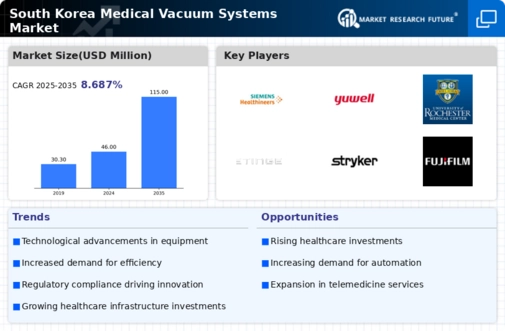Technological Innovations
Technological innovations are transforming the medical vacuum-systems market, with new features enhancing performance and efficiency. The introduction of smart vacuum systems equipped with sensors and automated controls is gaining traction among healthcare providers. These innovations not only improve operational efficiency but also reduce the risk of human error during procedures. In 2025, the market for technologically advanced vacuum systems is projected to account for over 30% of total sales, indicating a shift towards more sophisticated solutions. As hospitals and clinics seek to modernize their equipment, the demand for innovative medical vacuum systems is likely to rise, driving overall market growth.
Focus on Infection Control
Infection control remains a pivotal concern in healthcare settings, significantly influencing the medical vacuum-systems market. South Korea's healthcare authorities are emphasizing stringent infection control protocols, particularly in surgical and critical care units. The market is expected to grow as hospitals adopt advanced vacuum systems that ensure effective removal of contaminants and pathogens. The implementation of these systems is likely to align with national health policies aimed at reducing hospital-acquired infections, which have been reported to affect approximately 5% of patients. Consequently, the demand for high-quality medical vacuum systems is anticipated to increase as healthcare facilities prioritize patient safety.
Surge in Surgical Procedures
The medical vacuum-systems market is also being propelled by a surge in surgical procedures across South Korea. With advancements in minimally invasive surgeries and an aging population, the number of surgeries performed is on the rise. In 2025, it is estimated that over 1 million surgical procedures will be conducted, necessitating the use of effective vacuum systems for maintaining sterile environments. The reliance on medical vacuum systems for suctioning fluids and maintaining cleanliness during operations is critical. This trend indicates a robust demand for medical vacuum systems, as healthcare providers seek to enhance operational efficiency and patient safety.
Rising Healthcare Expenditure
The medical vacuum-systems market in South Korea is experiencing growth due to the increasing healthcare expenditure. The South Korean government has been investing heavily in healthcare infrastructure, which has led to the expansion of hospitals and clinics. In 2025, healthcare spending is projected to reach approximately $200 billion, reflecting a growth rate of around 6% annually. This increase in funding allows for the procurement of advanced medical equipment, including vacuum systems, which are essential for surgical procedures and patient care. As healthcare facilities upgrade their equipment to meet modern standards, the demand for efficient and reliable medical vacuum systems is likely to rise, thereby driving market growth.
Aging Population and Chronic Diseases
The aging population in South Korea is a significant driver of the medical vacuum-systems market. As the demographic shifts towards an older age group, the prevalence of chronic diseases requiring surgical intervention is increasing. By 2025, it is estimated that over 15% of the population will be aged 65 and above, leading to a higher demand for surgical procedures. This demographic trend necessitates the use of reliable medical vacuum systems to ensure safe and effective surgeries. The correlation between an aging population and the rising need for surgical interventions suggests a sustained growth trajectory for the medical vacuum-systems market.



















Leave a Comment